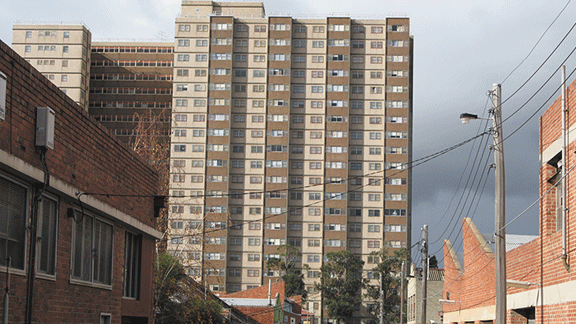Governments attack public housing tenants

A new report has found that the equivalent of the population of Bendigo is under housing stress in Victoria. Making Social Housing Work, published by a group of seven community organisations, estimates that one in seven families is unable to meet housing costs.
A separate report, The impact of Rent Assistance on housing affordability for low income renters, published by the National Welfare Rights Network, has found that more than half a million Australians, and 40 percent of those on rental assistance, are experiencing housing stress – defined as a low-income earner spending more than 30 percent of their income on rental costs.
The housing shortage for low income families in Victoria is so severe that an extra investment of $200 million a year will be needed just to keep pace with demand.
But instead of building more houses, state governments are attacking public housing tenants.
The Napthine government’s recently released framework “New Direction in Social Housing” introduces a series of punitive rules that specifically target public tenants – including probationary leases for new tenants and a requirement to sign up to a “neighbourly behaviour statement”.
State-wide laws apply to all tenants in Victoria, but the government has now singled out public housing tenants for special attention with pages of rules and guidelines that won’t apply to anyone else.
“The terminology talks about ‘anti-social behaviour’, but they do not define what anti-social behaviour is”, says Victorian public housing activist Kate Borland. “So you’re looking at someone who plays their music too loud, and that’s one strike. It could be that they’ve left out something on the side of their flat and someone complains about that. It means tenants are going be policing each other. You’re going to get a loss of community and a loss of trust between tenants.”
Treating tenants like criminals is part of the ongoing demonisation of public housing.
“Public housing was originally built to house low income workers in areas like the inner city, so they were the people doing the jobs. Nothing much has really changed except they are stigmatised and told that it’s ‘welfare housing’”, says Kate.
This shift in perception helps the government justify its plans to transfer management of up to 12,000 units to the community housing sector.
“We’ve got to remember that no financial exchange takes place; these are actually properties given over to the private sector … ‘Transfer’ is a give-away. So we’re taking it away from the public purse and putting it into the private purse.”
The New South Wales government has also made it easier to evict public housing tenants and introduced a tax on “spare” bedrooms. It’s also leading the charge to privatise public assets.
Millers Point residents in Sydney are currently locked in a battle with the NSW Housing Department to save their homes. The area is being cleared to make way for James Packer’s luxury casino. Meanwhile, a recently published report, “Who’s Really Hurting?”, estimates that the current social housing supply in NSW meets only 44 percent of need.
“What’s happened in Millers Point is the beginning of the end for a lot of inner city public housing throughout Australia, because it is million dollar real estate. Where I am in North Carlton: million dollar real estate. Fitzroy: million dollar real estate. All the areas that are being targeted, they are trying to gentrify”, says Kate.
What is needed is a coordinated effort Australia-wide to generate support for public housing.
When I spoke to Kate, she was on her way to Millers Point to join the campaign.
“When people are threatened with loss of their home or loss of their children, they are going to be too frightened to speak out. We need to encourage people to speak out, to lose the fear.”
[Follow Kim on Twitter @kim_doyle1]